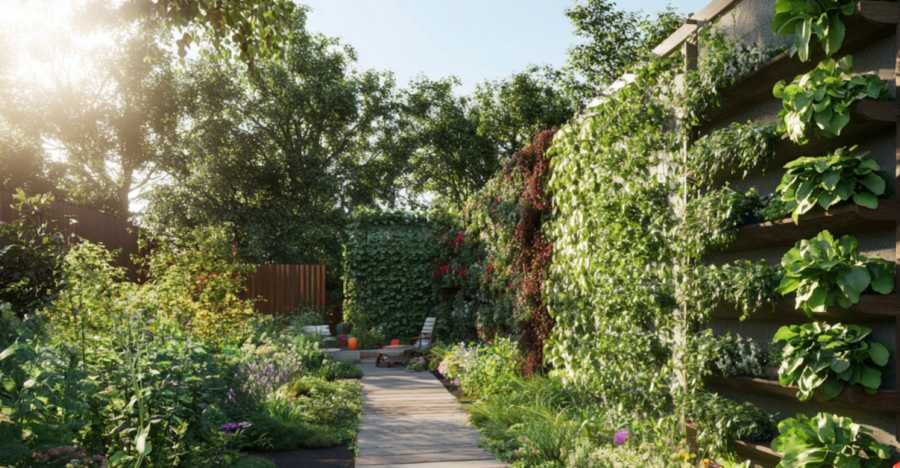Why Waste a Wall?
Most fences just sit there, existing. They don’t contribute to dinner, they don’t pay rent, and they certainly don’t bring you fresh basil when you’re making pasta. But what if they could? What if, instead of a blank stretch of wooden planks or brick, your fence could become a living, breathing pantry? Vertical gardening makes it possible to transform garden walls into productive food sources, turning wasted space into a lush buffet of fruits, vegetables, and herbs.What You Can Grow (And What You Shouldn’t)
Not every plant is suited for vertical living. Some are too heavy, some too stubborn, and some just have commitment issues. But plenty of delicious options thrive when given the right support.Great Choices for Edible Walls:
Herbs: Basil, thyme, oregano, mint, and chives are excellent candidates. They don’t demand much space, and they’ll be within easy reach when you need to snip a few leaves.
Leafy Greens: Lettuce, spinach, and Swiss chard grow beautifully in vertical planters. Plus, they don’t take long to mature, so you’ll have a continuous harvest.
Strawberries: These sweet little gems love growing in pockets or hanging baskets. And let’s be honest—plucking a strawberry off the wall feels downright luxurious.
Climbing Vegetables: Beans, peas, and cucumbers practically beg to be grown on trellises. Give them a little support, and they’ll reward you with fresh produce all season.
Plants That Will Make You Regret Everything:
Pumpkins and Watermelons: Unless you want to install a complex system of plant hammocks (which, let’s face it, would be both ridiculous and amazing), these heavy fruits are best left to the ground.
Corn: It’s tall, it’s needy, and it won’t respect your personal space. Let it do its thing elsewhere.
Choosing the Right Structure
Not all fences and walls are created equal. Some are perfectly suited for vertical gardens, while others need a little encouragement (or reinforcement).Wooden Fences: These are ideal for attaching planters, trellises, or wall-mounted pots. Just make sure to seal the wood properly to avoid water damage.
Chain-Link Fences: Often seen as the ugly duckling of garden barriers, chain-link fences are actually fantastic for vertical gardening. Peas, beans, and cucumbers will happily climb the metal grid, making it both useful and surprisingly attractive.
Brick Walls: While trickier to modify, brick walls can support hanging planters, wall pockets, or mounted shelves for container gardening. Bonus: They retain heat, keeping plants warmer on chilly nights.
Vertical Planting Techniques
Once you’ve chosen your structure, it’s time to turn that plain wall into a thriving food factory. Here are some of the best ways to maximize your vertical space:Pocket Planters: These fabric or felt pouches attach to walls and hold soil like tiny hanging garden beds. Perfect for herbs, strawberries, and leafy greens, they make your wall look like it’s wearing a delicious vest.
Hanging Pots: Simple and effective, hanging pots let you grow a variety of plants while keeping them easily accessible. Just be sure to secure them properly—falling basil pots can be hazardous.
Gutter Gardens: Repurposed rain gutters can be mounted horizontally along fences, creating long, narrow planting beds for lettuce, spinach, and small herbs. Bonus: It’s an excellent excuse to finally replace that sagging gutter on your house.
Trellises and Climbing Supports: For beans, peas, cucumbers, and other climbing plants, trellises are the way to go. Attach them directly to a fence or wall, or use free-standing supports if you prefer a bit of mobility.
Stacked Crates or Shelves: Old wooden crates or sturdy shelves can be arranged in layers to create a multi-tiered garden. Just be mindful of weight distribution—nobody wants to be taken out by a toppling tomato tower.
Keeping Your Vertical Garden Happy
Plants growing vertically need a little extra attention. Since they’re often more exposed to wind and sun, here’s how to keep them thriving:Water Wisely: Gravity isn’t just for apples and failed diet plans—it also affects water. Plants at the top will dry out faster, so consider installing a drip irrigation system or watering from the top down.
Soil Matters: Because vertical planters often hold less soil, use high-quality potting mix that retains moisture while providing proper drainage.
Fertilize Regularly: Nutrients leach out faster in vertical setups. A balanced organic fertilizer every few weeks will keep your plants productive.
Mind the Sun: Walls can create microclimates. A south-facing fence will be hotter and drier, while a north-facing one might struggle with shade. Choose plants accordingly.
Security Measures: Keeping Pests (and Neighbors) at Bay
A vertical farm might be efficient, but it also advertises its goodies to any passing pests—both insect and human.Slugs and Snails: These slimy thieves love leafy greens. Copper tape around planters or a sprinkle of crushed eggshells can deter them.
Birds: Strawberries hanging from your fence will make you very popular with the local bird population. Netting or reflective deterrents can help keep them from feasting before you do.
Nosy Neighbors: If your vertical farm is visible over the fence line, prepare for some garden envy. The best defense? Share a few tomatoes—it might just earn you some homegrown zucchini in return.
Wall-to-Table Success
A well-planned vertical farm turns wasted wall space into a lush, edible paradise. Whether you’re growing fragrant herbs, crisp greens, or juicy strawberries, the benefits are undeniable—fresh food, better space utilization, and the satisfaction of making your fence actually do something useful for once.So, grab those planters, get those trellises up, and start growing your meals vertically. After all, why settle for a boring wall when you could be harvesting dinner from it?
Article kindly provided by candenativelandscape.com


